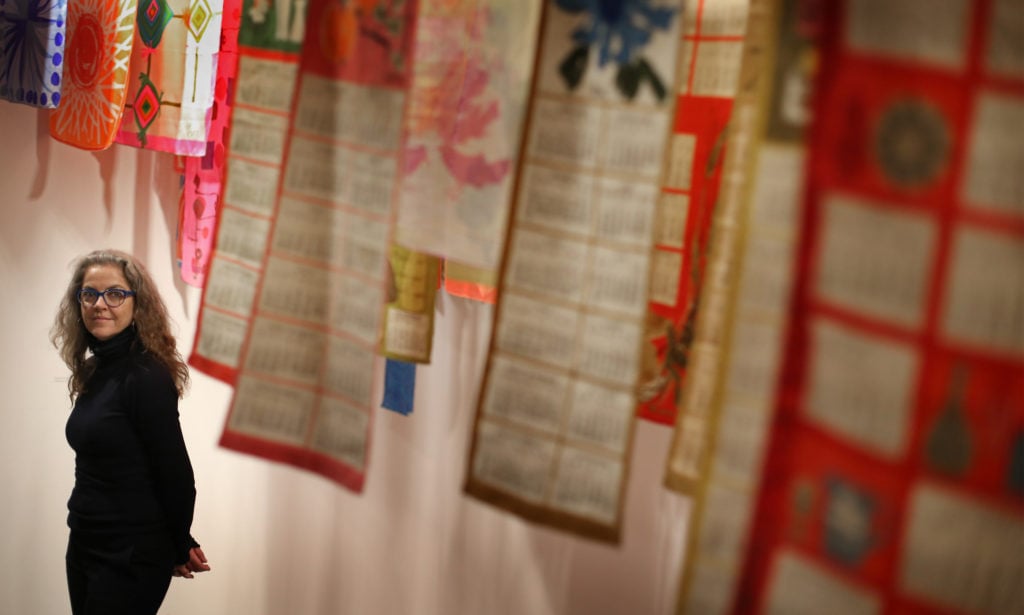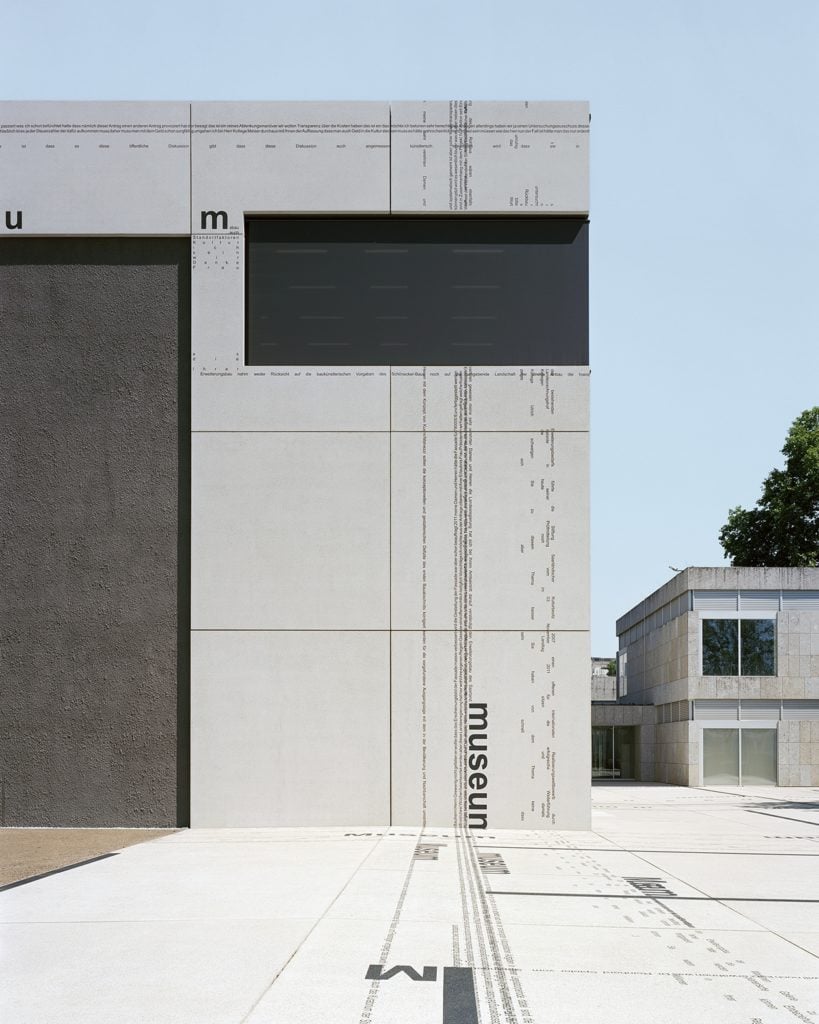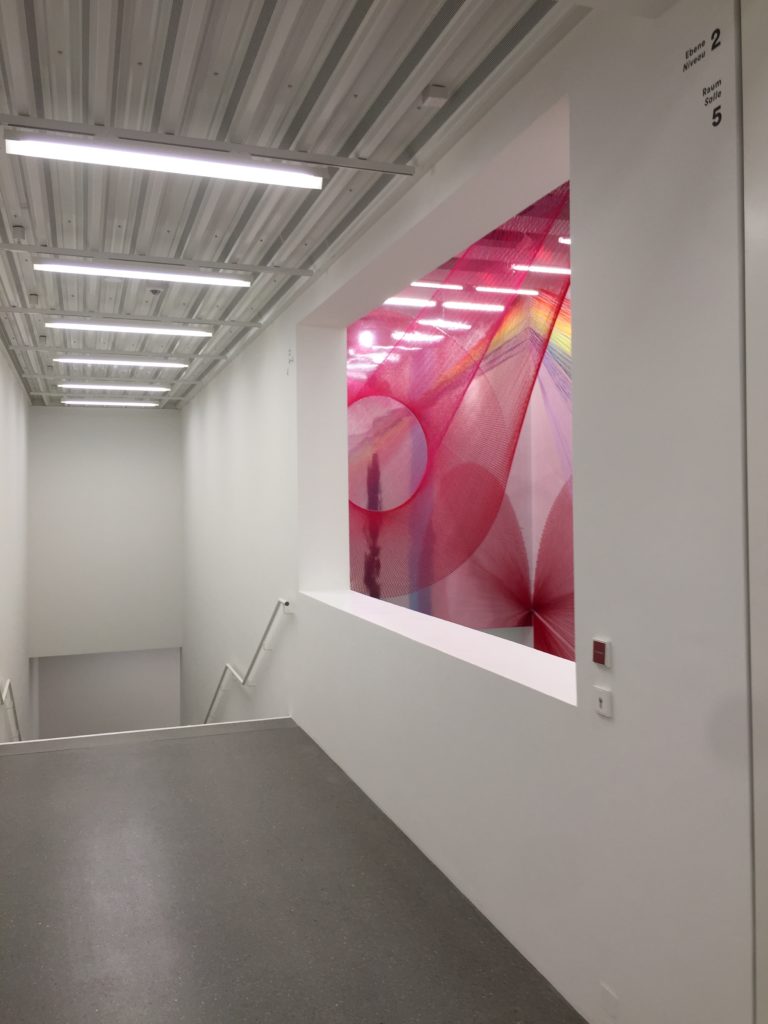Art World
Pae White on Turning a New Wing of Germany’s Saarlandmuseum Into a Technicolor Spacecraft
Polyester yarn was key to constructing this 45-foot-tall installation.

Polyester yarn was key to constructing this 45-foot-tall installation.

Naomi Rea

The Modern Gallery of the Saarlandmuseum in Saarbrücken, Germany, reopened to the public on Saturday after a year-and-a-half-long closure for the construction of an extension, designed by Berlin architects Kuehn Malvezzi.
An exhibition of new works by the American artist Pae White inaugurates the museum’s new wing, which adds eight rooms and an additional 1,500 square meters of exhibition space. White is known for her large-scale installations and her multimedia work, which has appeared in the 2009 Venice Biennale and the 2010 Whitney Biennial.
On Saturday she unveiled her latest work, Spacemanship, a site-specific, super-graphic intervention that plays with the architecture of the new wing and completely fills its 45-foot-tall atrium. The work was created in situ and was designed around the space so that it is visible from every floor of the building.
For this edition of “Origin Story,” which explores the backstories of individual works of art, Pae White spoke to artnet News from Germany to take us through the process of putting together Spacemanship, how she engaged with the space, and why cheap polyester yarn is a perfect material.

Saarlandmuseum Moderne Galerie. Photo ©Hans-Christian Schink.
What was the inspiration for the title of the installation, Spacemanship?
The title of the installation is also the title of the exhibition, and I just felt like it encapsulated what was going on. The installation is at least four floors high, and architecturally there are a number of apertures, so as one travels through the space you can kind of look down and the installation changes and things line up, and other things fall apart. It’s all about how this piece changes if you were to be floating in space like a spaceman and, because of the architecture, you kind of are.
There are at least four opportunities to look down on this piece or look up to it from different floors. The title is also heavily referential to crafts. There’s the idea of craftsmanship, and probably the most basic craft material runs predominantly through the space: this really inexpensive polyester yarn that has worked for me for many years. It’s a really plain, basic material that people crochet with. It was just kind of the perfect solution for having this intensity, intention that I wanted, and it’s inexpensive. It just behaves perfectly; it never really breaks and it’s always on sale. We actually dyed a bunch of yarn and had this custom textile made for Venice in 2009 and this other really inexpensive stuff just behaved much better.
The space is so extremely vertical it actually reminded me of this place that I’m referencing in northern California called the Sea Ranch, although it’s very different architecturally in terms of the spirit of it. The architecture is very rough on the outside but once you go inside they open up, like geodes, so it’s sort of like these unpainted wooden buildings with experimental shapes and forms and then inside you might come into a public space and it’s all crazy super graphics, it’s very dense and an extremely different experience. They also have many conditions where the walls open up, windows, and barn doors flying in the space and this space reminded me of that. It’s weird. This is a very white, hard space as opposed to the rough wooden variation in northern California, but there was a connection.

Pae White, Spacemanship, installation view, Saarlandmuseum Moderne Galerie. Photo by Tom Gudelwein, ©Pae White. courtesy the artist and neugerriemschneider, Berlin.
Did you face any challenges in bringing your vision to life?
We had a technical issue this morning but there wasn’t really anything I could do, so I’m just getting updates. For the most part we’re ahead of schedule so I think this problem is kind of okay. I’m getting images from my assistant but I think it’s going to be okay. It’s a problem in the atrium: We drilled into the floor and we keep watching the screw loosen more and more and there’s a lot of tension on it and this morning I guess it snapped. Well, the yarn pulled the eye hook out of the concrete. But the good news is that it happened while we were here, and it didn’t happen when people were in the space.
No major challenges other than that. My own challenge is that we’re doing a catalogue and it’s one of those things that I’m dragging my feet on because I used to design books and catalogues and I know that once I get involved I’m going to want to take over and I can’t. So the biggest challenge is my own personal psychological problem with having to get that part done but other than that it’s been really, technically, fine.
How long did it take to put together?
It probably took a month. We’re still kind of doing a few refinements but my assistant was here for three weeks in July and then he showed up a week ago and they finished one more thing they couldn’t finish then, so it’s basically been completed at the end of July and it’s just been kind of sitting there until we could do the rest of the exhibition. We had the luxury of the energy of the museum being put in the other buildings, so we had this kind of space that nobody would really interfere with for a solid month.
Your work often straddles the line between art and design. Where do you locate this installation?
I always feel like it’s art and if I have anything that kind of seems like I’m crossing the line it’s really just using this design element as a raw material. In this case, these particular graphics were harvested from locations in northern California and, again, I just sort of see that as a raw material, an inspiration. I’m very interested in design, and I’ve created books and things like that, but I always see them as art. I like to work off of people’s assumptions about what design is and what it does and maybe pull that apart or turn it upside down, but I see this as absolutely an artwork.

Saarlandmuseum Moderne Galerie. Photo: ©Hans-Christian Schink.
Why the Saarlandmuseum? How did that collaboration come about?
I had a show in Berlin about three years ago and I met Dr. Roland Mönig and I visited the museum’s beautiful collection. The existing building is super beautiful and he’s great. He reminds me of Alex Farquharson or even Greg Burke, these people who are curators that become directors and the next thing you know they’re overseeing a huge museum construction project. It’s always interesting for me to see somebody who has to wear all the hats, so this is another situation like that and he’s been great, really supportive. So it was a response to an invitation.
What’s next?
We’re actually working on something next month in Melbourne for the triennial there, and we’ll do some variation of this. This is like the second time I’ve played with this and let the space and its extremes shape the application, and the way the viewer moves through the space is very much determined by the space itself.
It’s interesting because I’ve seen the site and this is maybe my fourth or fifth time here, and the third time I just changed it, I thought, Okay, we’re not going to do what I originally thought, just seeing the space without the scaffolding and understanding the height. In Melbourne, it’ll be way more straightforward, much more direct, much more of a classic one-story horizontal space. So it’ll be different, but I save these elements and we start applying them in other situations. I don’t know if I’ll do it again after Melbourne, but this was just too great of an opportunity to not do.

Installation view of Spacemanship (2017). Photo: Pae White, courtesy of the artist.
If you could dictate what a visitor experiences when they enter the installation, what would you hope they came away with?
I think my piece in some ways just becomes a device to get someone to physically move through a space and I think as you start moving up the stairs then you start to see these opportunities, you start to see this piece change. You see things that you didn’t see until you got up to the second floor; what wasn’t present on the first floor and is invisible on the third floor. Then you keep going and, in fact, my favorite view of all is on the fourth floor. It’s this one little moment of tremendous architectural minimalism and then this reveal of—it’s almost like the heart, the organs, of the building, like this lush mystery happening from a peekaboo view, and I really like that. It’s about mutually rewarding the viewer. The viewer makes the effort and you’re grateful, and the piece responds to that in some way. There’s this desire to maybe see it again and again. I like the idea of this stuff being unseen, or that there’s something unseen and that would generate more intrigue, at least that’s what I hope for.
“Origin Story” is a column in which we examine the backstory of an individual work of art. “Spacemanship” is on view at the Saarlandmuseum in Saarbrücken until March 18, 2018.